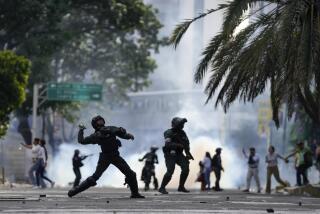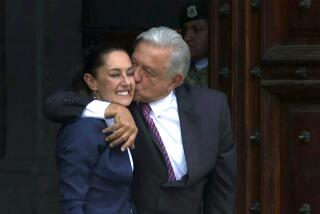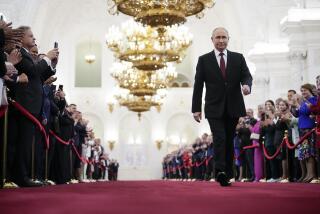NEWS ANALYSIS : Reformers Face a Rough Road After Elections
MOSCOW â When Yegor T. Gaidar launched free-market reform in Russia, he described himself as a âkamikaze.â His goal was to make the march toward capitalism irreversible--a task he predicted would be political suicide.
On Monday, as returns came in from the countryâs first post-Soviet multi-party election, the 37-year-old economy minister looked like the badly wounded leader of a pro-government party, fighting for his political life against the ultra-nationalists and Communists who are likely to dominate the new Parliament.
Whether Gaidarâs radical Western-backed experiment will go down with him is the central question facing Russia after two years of economic and social upheaval that prompted voters to shun Gaidar and other reformers in favor of candidates with free-spending populist solutions.
The answer will come over the next few weeks, as reform and opposition forces compete for allies among centrists and independents in Parliament and as President Boris N. Yeltsin ponders the choice of a prime minister who can work with the majority bloc.
Awaiting the outcome is a country far different from the one Gaidar set out to remake in January, 1992--yet one still in the fragile, infant stage of development toward a stable free-market democracy.
âI have the feeling that anything can happen now,â Harvard economist Jeffrey Sachs, a leading adviser to Gaidarâs reform team, said in an interview here Monday. âSo much has been accomplished, yet I am afraid Russia may be on its way to getting lost. The best moment may be gone.â
In a single stroke at the start of 1992, Gaidar destroyed the Soviet system of centralized distribution by freeing nearly all prices. Weeks later, he launched a privatization program unrivaled anywhere in speed and scope. Today more than a third of the labor force works in private enterprise.
Money quickly replaced barter as the basis for trade. Russians with skill and drive are now better off, able to vacation abroad and buy imported goods. Tens of thousands of street traders flood Moscow and other Russian cities, hawking everything from television sets to cars.
These sudden transformations were Russiaâs version of âshock therapy,â the initially painful but ultimately successful formula in Polandâs transition to capitalism since 1990. But here, Soviet-era industrial managers and lawmakers blocked Gaidar from applying an essential element of shock therapy: stabilizing the money supply and controlling inflation.
âThere was a democratic revolution here but not a revolution of control,â said Charles A. Blitzer, chief economist of the World Bank mission in Moscow. âThe old guard still have their jobs.â
Rather than making bankrupt industries close down and throwing people out of work, Gaidar was forced to let them accumulate huge debts to each other and periodically bail them out. Unemployment here is still low by Western standards.
The bailouts drove Russiaâs inflation rate to 2,500% in 1992 and about 1,000% this year, wiping out personal savings. Caught in a twilight zone between reform and resistance, most Russians became poorer than they were under Communist rule.
Some in the West, including Sachs, fault the United States and other rich industrial nations for failing to deliver enough aid and political support to help Yeltsinâs team resist the bailouts. They argue that Russiaâs reforms lost their momentum in the summer of 1992 and never recovered.
Gaidar was forced to resign as acting prime minister a year ago today. His team of deputies remained in the government, but it was not until three months ago, when Yeltsin brought Gaidar back as economy minister and dissolved Parliament, that the political deadlock over reform was broken.
Reformers moved quickly to tighten wasteful subsidies to money-losing factories and farms, break up state-controlled monopolies and bring down inflation. Prices, which once rose 25% a month, went up just 15% in November and 2.9% the first week of this month. The ruble stabilized against the dollar.
Such recent success may be proof that Russia needs a dictatorship to impose the free market and make it work--as Chile had for much of the 1970s and â80s. But Yeltsin chose to let Russians elect a new Parliament, hoping it would be more reform-oriented than the last.
Everywhere reform candidates stumped, however, people complained of inflation, organized crime, fear of layoffs, paychecks that came a month late. They could not shake the image, personified by Gaidar, of technocrats aloof from the cruelties of capitalism.
âThey do not care about people like myself and my children,â said Yelena G. Alexandrova, an architect who attended a candidatesâ debate in a Moscow suburb. âAll they do is make experiments, trying out one economic model after another. We are just like guinea pigs, meant for tests and experiments.â
More to Read
Sign up for Essential California
The most important California stories and recommendations in your inbox every morning.
You may occasionally receive promotional content from the Los Angeles Times.










